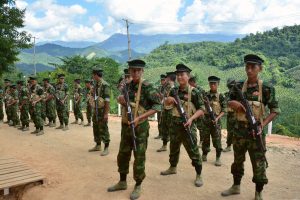An American businessman based in Yangon recently pitched the Trump administration on a questionable minerals deal.
According to Reuters, the ex-Marine floated the idea of a U.S.-brokered truce between Myanmar’s military and an armed group that captured rare earth mines in a landlocked region near the border with China. The proposal, presented to the office of Vice President JD Vance, envisioned an alternate supply chain, routing the transportation and processing of the minerals through India.
The high-level engagement, described as a “courtesy” to the American overseas business community, was an unspoken acknowledgement of the rising international profile of the Kachin Independence Army (KIA). The armed group’s seizure of the Chipwe-Pangwa mining belt in October was a notable inflection point in its decades-long insurgency.
The KIA’s victory cemented the Kachin insurgents’ role as de facto “gatekeeper of strategic resources” in Myanmar, wrote Amara Thiha, a fellow at the Washington, D.C.-based Stimson Center.
At its peak in 2023, the largely illicit rare earth trade injected more than a billion dollars into Myanmar’s economy. The northeast region is rich in ores containing dysprosium and terbium, elements used in the manufacture of high-performance magnets. Dysprosium alloys prevent smartphones from overheating, and terbium is used in energy-efficient lighting.
Rare earth oxides extracted from the Kachin hill slopes using leaching agents are trucked across the border to China, which has a virtual monopoly on the refining of ores and the production of magnets. Given its investment in the supply chain, China should have been the obvious candidate to broker a truce between the military and the Kachin rebels.
Apart from a shared interest in ore extraction, however, the KIA’s goals for an integrated homeland are not aligned with Beijing’s need for military-backed stability in Myanmar. China reportedly urged the rebels to abandon their efforts to capture Bhamo, a strategically important city on the Irrawaddy River. “If the KIA can capture Bhamo, it will effectively control all of eastern Kachin State,” commented Michael Martin of the Center for Strategic & International Studies (CSIS) in Washington, D.C.
Reuters reported that Beijing had threatened to cut off rare earths purchases if the KIA persists with its offensive in Bhamo.
Customs data shows that China’s imports were down by 50 percent in the first few months of 2025 as the fighting intensified. Airstrikes by the military reportedly killed 4,600 KIA-led fighters and severely damaged parts of Bhamo. “An early ceasefire and peace talks between the Myanmar military and the Kachin Independence Army are in the common interests of China and Myanmar as well as their people,” said a spokesperson for the Ministry of Foreign Affairs in Beijing.
However, a political analyst in Kachin State said the rebels had started exploring “alternative options” for the minerals. Dan Seng Lawn, executive director of Kachinland Research Centre, who had attended an online discussion with a team from India, pointed out that internal “power dynamics” in Myanmar were shifting.
India had requested rare earth samples from Myanmar and reportedly contacted companies in Japan and South Korea about collaborating on the manufacture of magnets. India’s Prime Minister Narendra Modi mentioned rare earth mining in a Facebook post after a meeting with Myanmar’s military chief Min Aung Hlaing on the sidelines of the SCO (Shanghai Cooperation Organization) Summit in August.
The plan to transport minerals along an India-Myanmar road has been met with some skepticism outside the region. The Stimson Center’s commentary notes that India’s northeastern border states are “conflict-affected” and not well connected to refining facilities further south. Gregory B. Poling, director of the Southeast Asia Program at CSIS, pointed out that “the investments necessary to transport and process in India would be enormous.”
Journalist Bertil Lintner, who wrote about his travels through the region in the book “Land of Jade: A Journey from India through Northern Burma to China,” indicated that the mountain roads between the two countries were not suitable for bulk shipments of ores.
The western route for transporting Myanmar’s rare earths may turn out to be a commercial non-starter. But the threat of an alternate supply chain might force China to offer a better price for Kachin State’s prized minerals.





























